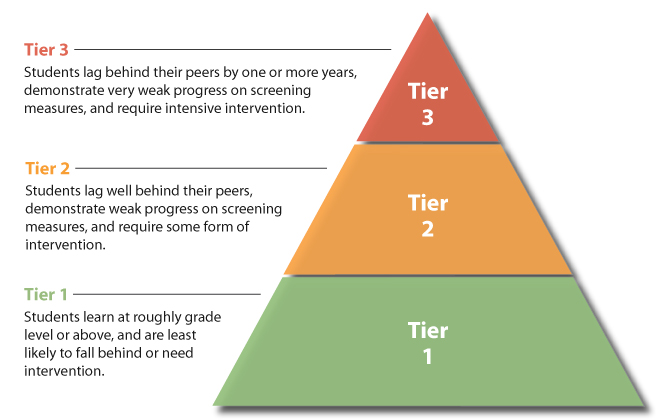Unit 7- Tiered Lessons
Differentiated instruction requires that the teacher provide a flexible curriculum that is responsive to individual student’s needs, interest areas and learning styles (Tomlinson, 2001). Tiered instruction is a strategy used under differentiated instruction to ensure that learning activities are designed to match each learner’s cognitive ability and readiness while the contents are kept the same (Johnson, 2010). This tactic can be used to effectively address the needs of all students in the classroom and ensure that everyone is learning at the level most comfortable for him/her. Pullen et al. (2010) reviewed tiered instruction as a model used to help young children build vocabulary in order to prevent later reading disabilities. Providing an intervention to learners who are behind can help boost them to attain a high learning level. The purpose of their study was to show that if this mode of instruction is used in building early vocabulary knowledge then, there will be less at-risk children for reading in later grades.

They utilized the response to intervention (RTI) model in their research. This model is used in most cases when students are perceived to be at risk for academic failure. It is a tiered intervention approach that is usually implemented across two, three or more levels of instruction (Pullen et al., 2010). The research consisted of 224 first grade students in a medium sized school district. The student sample consisted of 98 students at risk (AR) for language difficulties and reading failure and 126 students who were not at risk (denoted as NAR) (Pullen et al. 2010). Both of these categories were determined using a standardized test for receptive language PPVT-4 in which AR students scored below the 39th percentile and the NAR students scored above the 39th percentile. A prottest measure was designed for classroom teachers to keep track of students’ acquisition of target words because of its capability to detect change in a short-term period. The intervention groups were divided into three: AR treatment (ART), AR control (ARC), and NAR. These groups were compared for depth of vocabulary knowledge, receptive knowledge, context knowledge, and expressive knowledge using a prottest on a two weeks interval following the start of administering intervention to the AR group (Pullen, 2010).
A general education teacher offered ART group students Tier 1 instruction while a graduate student in education offered them supplementary Tier 2 instruction. ARC group students only received Tier 1 instruction from the general education teacher. The lesson for both Tiers were designed around two first grade appropriate storybooks in which four target vocabulary words were selected in each book (Pullen et al., 2010). All 224 students received Tier 1 class-wide instruction by a certified first grade classroom teacher. Each lesson lasted for about 30 minutes in which the teacher read the storybook out loud two days out of the week and conducted proofreading vocabulary activities in a large group setting. Tier 2 instruction was conducted in smaller groups on days following Tier 1 instructions. This intervention lasted for about 20 minutes and consisted of four to five students at a time. The aim of Tier 2 intervention was to intensify the support provided for students who were at risk for reading failure (Pullen et al., 2010).
At the end of the research, it was found that AR students who received an additional Tier 2 instruction showed a significantly higher prottest scores when compared to the students who only received Tier 1 instruction. Hence, “this finding suggests that AR students who received Tier 1 instruction alone may not learn target vocabulary words at sufficient enough depth and that students gain statistically significant educational benefit when they receive Tier 2 instruction” (Pullen et al., 2010). This further solidifies the fact that differentiating instruction at children’s developmental levels can provide many academic gains and lead to a higher academic attainment. Tiered activities also allow the teacher to offer additional support to students who may need it and allows instructions to be differentiated in order to provide that support as was evidenced in this article.
Question: How can we ensure that student’s show a consistent advancement in their learning progression and we are not barred in any way in placing them on levels we think are developmentally appropriate for them?
References
Johnson, A. (2010). Blooms Taxonomy to create tiered instruction [Video file]. Retrieved from https://www.youtube.com/watch?v=anLc37a8WOE
Pullen, C. P., Tuckwiller, E. D., Konold, T. R., Maynard, K. L., & Coyne, M. D. (2010). A tiered intervention model for early vocabulary instruction: The effects of tiered instruction for young students at risk for reading disability. Learning Disabilities Research & Practice, 25(3), 110-123.
Tomlinson, C. A. (2001). How to Differentiate Instruction in Mixed-ability Classrooms. Alexandria, Va: Assoc. for Supervision and Curriculum Development.